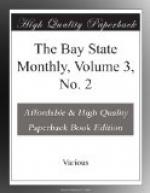Deacon David had seven children, of whom five attained majority and became heads of families; three of this number are now living, two sons and a daughter; and there are fifteen grandchildren. He retired from active business in 1875, but interested himself in the affairs of the Church, and in the business of a son in Boston. But his health, never very robust, became impaired with the advance in years, and he withdrew more and more from public notice. His wife and children were constant with their grateful ministrations, and, under the oversight of attentive physicians, his life was prolonged beyond expectation. He retained his mental powers in great activity until the end, his memory of recent, as well as remote occurrences, serving him with unusual accuracy. He was seldom depressed, and had none of the “melancholy damp of cold and dry,” of which Milton speaks, to weigh his spirits down. Being able to see friends, he conversed with the animation and intelligence of one in middle life.
The change came at length, and sustained by an unfaltering trust in the Lord Jesus, whom he had publicly confessed for nearly half a century, he fell asleep on the third of September, 1883. He had lived with his wife fifty-seven years, and in the same house for fifty-two years. Soon after his death, the Church adopted formal resolutions, setting forth the grounds of their gratitude to God for his valuable life and services as an officer, and expressing the sincere affection with which they cherished his memory as a citizen and friend.
* * * * *
THE BOSTON LATIN SCHOOL.
The one educational institution in this country which has the honor of ante-dating Harvard College by a few years, and of thus being the very oldest in the land, is the Boston Latin School. For two hundred and fifty years it has been a part, and an important part, of the town and city of Boston, influencing all its other institutions, social, literary, moral, political, and religious, and largely giving to the metropolis, directly or indirectly, its wide-spread fame as the “Athens of America.”
The establishment of this School has its origin in a vote of which the following is a transcript:
“... 13th of the 2d moneth 1635 ... att a General meeting upon public notice ... it was generally agreed upon, that our brother Philemon Pormout shall be intreated to become scholemaster for the teaching and nourtering of children with us.”
At this time, Boston was a village of perhaps, fifteen hundred inhabitants, and it was a hundred years later before it had reached as many thousands.
The first school-house was on the north side of School street, close by the burying-ground which had already received the mortal dust of several of the early settlers. It was a century before King’s Chapel was built, but at the foot of School street, near the site of the Old South meeting-house, was Governor Winthrop’s imposing mansion; and nearly opposite this, was the Blue Lion Tavern.




